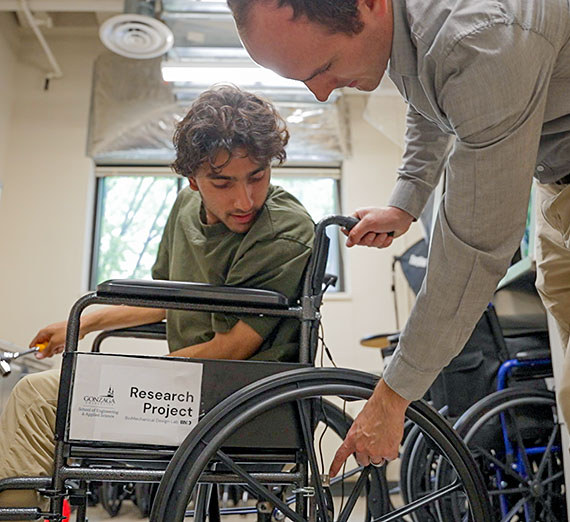Improving Access: Gonzaga Students Design a Better Wheelchair

These students went into their summer research project knowing they would be putting their classroom knowledge to use. What they didn’t know is how their work could be applied to real people on their own campus.
This summer, Gonzaga University’s Biomechanical Design Lab offered a student-led eight-week research program to develop a low-cost suspension system that can be attached to existing manual wheelchairs. Overseen by Professor Brandon Sargent, director of biomedical engineering, students were allowed the freedom to test different materials, run multiple tests and trials, and practice coding.
“I wrote a lot of the code,” says Benjamin Harris (’26, Mechanical Engineering), “but we did all the manufacturing together and then all of the brainstorming, that was a lot of the team effort.”
The research team’s main goal was to test a mechanism that flexes to absorb and reduce vibrations when wheelchair users are faced with rocky surfaces such as cobblestone or brick walkways. These surfaces are often found on college campuses, making it difficult for students using manual wheelchairs to move comfortably.

Sargent, director of the biomedical engineering program at Gonzaga University, helped prepare the students for this project during the spring semester. He invited some of his former students to join the research team, giving them a head start in tackling the challenges ahead. Not all team members had taken his courses, but together they combined their skills and knowledge.
“Choosing a material that we wanted to use for our spring and how to properly do that was a big part of the research,” says Harris. “I actually took a class with Dr. Sargent last spring called Machine Design, and it was really helpful for figuring out how long the material would last.”
After the program wrapped up, the students reflected on the experience as more than just an academic exercise. They had the chance to apply their classroom knowledge in a practical setting, collaborate as a team, and directly contribute to improving accessibility for others. The challenges they faced strengthened their problem-solving skills and deepened their appreciation for engineering’s real-world impact.
For students considering summer research, this program highlights the lessons and impact that each student can pull from a project.
